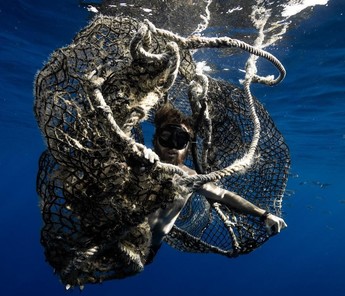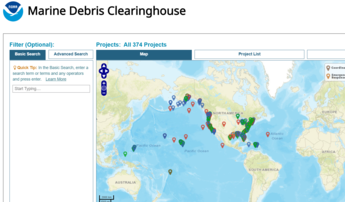| Header Photo: Derelict fishing nets recovered from the Papahānaumokuākea Marine National Monument (Photo credit: NOAA).
 Microplastics sieved from Kaua'i beaches (Photo credit: Robert Zelkovsky).
Submitted by: Carl Berg, Surfrider Foundation Kaua'i Chapter
A first in the USA!
In February 2020, Surfrider Foundation, Center for Biological Diversity, and Sustainable Coastlines Hawaii sued the U.S. Environmental Protection Agency (EPA) to address plastic pollution under the Clean Water Act. The lawsuit challenged EPA's failure to examine studies showing widespread plastic pollution in Hawai'i’s coastal waters and declare the waters “impaired” under section 303(d) of the Clean Water Act. EPA has responded to the lawsuit by withdrawing their erroneous list of impaired waters in Hawai'i that failed to take into account water quality impairment due to plastic pollution. The EPA has ordered Hawai'i to now examine the impact of plastic pollution on its ocean, beaches, and wildlife.
Learn more.
 Drew McWhirter simulating a marine mammal entanglement in a ghost fishing net in the North Pacific gyre while on the Vortex Swim Expedition (Photo credit: Corbin Marshall).
Submitted by: Jennifer Lynch, NIST; Center for Marine Debris Research
Hawaii Pacific University’s (HPU) Center for Marine Debris Research has been funded by the Norwegian Retailers’ Environment Fund to remove ghost fishing nets from Hawai'i’s coral reefs and study the sources. This will kick-start an important program to combat the plastic pollution problem in Hawai'i. Ideally, a long-term program for monitoring and at-sea removal in Hawai'i will be created in partnership with the responsible fisheries. If we can detect, track, and remove the gear at sea, we can prevent damage to the reefs. Drew McWhirter will perform the study as his master’s thesis at HPU. Ocean Voyages Institute and Papahānaumokuākea Marine Debris Project are providing net samples from the North Pacific gyre and Northwestern Hawaiian Islands.
Learn more.
 The redeveloped Marine Debris Clearinghouse allows you to easily query for information (Photo credit: NOAA).
Submitted by: NOAA Marine Debris Program
The Marine Debris Information Clearinghouse has been redeveloped to add new features and capabilities. First launched in 2013, the site is designed to provide direct access to the marine debris community on projects completed or underway that can inform and improve their work. The Clearinghouse allows researchers and other active or interested partners to find projects and the results based on different project attributes, including location, project type, time frame, partner, or debris type.
Learn more.
Submitted by: Carl Berg, Surfrider Foundation Kaua'i Chapter
Huge amounts of medical and take-out plastic/polystyrene waste is being generated during the COVID-19 pandemic and has a potential of ending up in the ocean.
I recommend that the marine debris clean-up community do three things once we are allowed back on the beaches:
1) Advise everyone doing cleanups that medical items (e.g., gloves, masks, wipes) found on the beach or in the water are dangerous, should only be handled with gloves, and should be disposed of properly.
2) Advise your local communities that these protective items must be disposed of properly.
3) Beach cleanup crews start recording the types and amounts of these items so as to identify the sources and stop it from occurring on the beaches.

The articles written by partners are not the opinions of the National Oceanic and Atmospheric Administration (NOAA) and does not imply that NOAA recommends or endorses those expressed by partner organizations. These opinions and their associated actions will be carried out by interested partner organizations and are not affiliated with NOAA or the NOAA Marine Debris Program. |